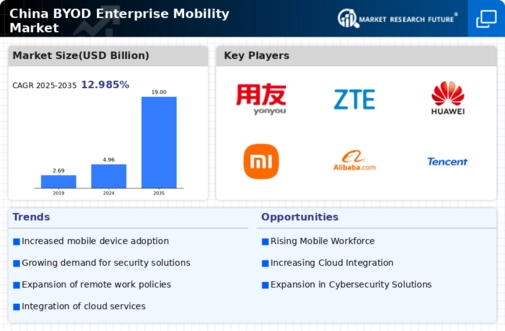The byod enterprise-mobility market in China is characterized by a dynamic competitive landscape, driven by rapid technological advancements and an increasing demand for flexible work solutions. Key players such as VMware (US), Microsoft (US), and IBM (US) are at the forefront, each adopting distinct strategies to enhance their market presence. VMware (US) focuses on innovation through its cloud-based solutions, aiming to streamline enterprise mobility management. Microsoft (US), leveraging its extensive software ecosystem, emphasizes integration and user experience, while IBM (US) prioritizes security and compliance, catering to enterprises with stringent regulatory requirements. Collectively, these strategies foster a competitive environment that encourages continuous improvement and adaptation to market needs.
In terms of business tactics, companies are increasingly localizing their operations to better serve the Chinese market. This includes optimizing supply chains and establishing partnerships with local firms to enhance service delivery. The market structure appears moderately fragmented, with several players vying for market share, yet the influence of major companies remains substantial. Their collective actions shape industry standards and drive innovation, creating a competitive atmosphere that benefits end-users.
In October 2025, VMware (US) announced a strategic partnership with a leading Chinese telecommunications provider to enhance its cloud services tailored for local enterprises. This collaboration is expected to bolster VMware's market position by providing localized solutions that address specific regulatory and operational challenges faced by Chinese businesses. Such partnerships are crucial in navigating the complexities of the Chinese market, where local knowledge and compliance are paramount.
In September 2025, Microsoft (US) launched a new suite of security features within its enterprise mobility platform, specifically designed to address the unique cybersecurity threats prevalent in China. This move not only strengthens Microsoft's competitive edge but also reflects its commitment to safeguarding user data in a region where data privacy is increasingly scrutinized. By prioritizing security, Microsoft positions itself as a trusted partner for enterprises looking to adopt BYOD policies without compromising on safety.
In August 2025, IBM (US) expanded its presence in China by opening a new research and development center focused on AI-driven enterprise mobility solutions. This initiative underscores IBM's dedication to innovation and its recognition of AI's potential to transform enterprise mobility. By investing in local R&D, IBM aims to tailor its offerings to better meet the needs of Chinese enterprises, thereby enhancing its competitive positioning in the market.
As of November 2025, the competitive trends in the byod enterprise-mobility market are increasingly defined by digitalization, sustainability, and the integration of AI technologies. Strategic alliances are becoming more prevalent, as companies recognize the value of collaboration in enhancing their service offerings. Looking ahead, competitive differentiation is likely to evolve, shifting from traditional price-based competition to a focus on innovation, technological advancement, and supply chain reliability. This transition suggests that companies that prioritize these aspects will be better positioned to thrive in an increasingly complex market.



















Leave a Comment